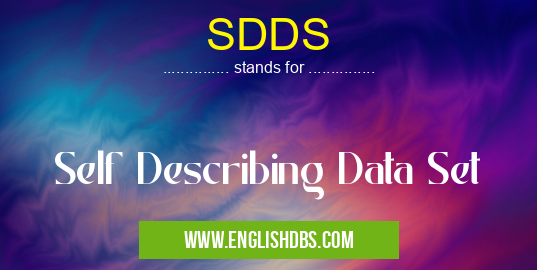What does SDDS mean in DATABASES
SDDS stands for Self Describing Data Set. It is a data format that combines both data and descriptive elements in the same file or network stream. This allows for easy identification and interchange of data, reducing the need for complex external documents to be included with the data. The SDDS format captures all aspects of the dataset including structure, attributes, content and various other details. This makes it easier to use datasets in different applications without requiring a manual translation of their contents.

SDDS meaning in Databases in Computing
SDDS mostly used in an acronym Databases in Category Computing that means Self Describing Data Set
Shorthand: SDDS,
Full Form: Self Describing Data Set
For more information of "Self Describing Data Set", see the section below.
Definition
SDDS is an acronym for Self Describing Data Set. It provides an efficient way for exchanging information by combining both data files and their accompanying metadata into a single package. This ensures that all important details about a given dataset are preserved, making it easier to access its contents from diverse programs or applications. In effect, this eliminates the need to manually convert datasets into separate formats every time they are accessed by different applications as the SDDS format contains all necessary specifications within itself.
Benefits
The main advantage of using SDDS is that it simplifies access and interchange of data across multiple applications. By packaging together both dataset files and associated metadata, users can quickly assess what sort of additional steps need to be taken before they can begin working with a given set of information. Moreover, the undeniable benefit of having all attributes conveniently stored in one place greatly reduces clutter when dealing with large collections of datasets as each one only needs to be examined once before being placed into use without any manual translations needed before or after.
Essential Questions and Answers on Self Describing Data Set in "COMPUTING»DB"
What is an SDDS?
SDDS stands for Self Describing Data Set and is a file format that organizes data in a way that allows it to be easily read and understood. It includes detailed information about the structure, content and format of the dataset, so that it can be interpreted accurately.
How does an SDDS work?
An SDDS file is designed to provide a description of the data stored within it and its associated metadata. This allows software programs to understand and interpret the data correctly so they can process it appropriately.
What type of information is included in an SDDS file?
An SDDS file usually contains information about the number of columns and rows in a dataset, their labels, data types, units of measure, descriptive statistics and other descriptive metadata.
Why are SDDS files useful?
By allowing software programs to understand the structure and contents of datasets quickly and accurately, SDDS files make it easier for programmers to quickly build applications that can take advantage of these datasets.
Are all datasets in an SDDS format?
No, not all datasets are formatted using SDDS standards due to their complexity. However, most modern software programs have mechanisms for automatically converting non-standard datasets into SDDS format if necessary.
Can I edit an SDDS file?
Yes — provided you have access to suitable software with support for self-describing data sets (SDDs). In most cases this means professional programming tools such as SQL or Python and appropriate libraries.
What are the benefits of using an SDD strategy?
Using an SDDs strategy has numerous benefits including less time spent on documentation or manual formatting; improved quality control over your data; greater enforcement of uniform standards; faster importation into other applications; better compatibility between different platforms; quicker processing times; increased usability across multiple platforms; enhanced security; easier application development; and fewer errors during integration processes.
Where can I find more information on using self-describing datasets?
A great resource for further reading on self-describing datasets is the official website on self-describing formats maintained by blosxom technologies (www.blosxomtech.com/sdds). Here you will find tutorials, FAQs, developer resources, related links etc relating specifically to this topic.
Is there any software available to help me create or manage my own self-describing dataset?
Yes - there are several commercial options available from companies such as blosxom Technologies which offer comprehensive support for your own customised self-describing formats as well as importing pre-existing ones such as CSV or XML files.
Final Words:
In conclusion, SDDS provides a great deal of convenience when it comes to working with datasets across multiple applications or programs due its ability to store both structural information and content within a single file or stream instead of having users manually process them each time they wish to access them from another application. Its presence has made dealing with large amounts of information less cumbersome as it removes much of the tedium associated converting datasets between formats.
